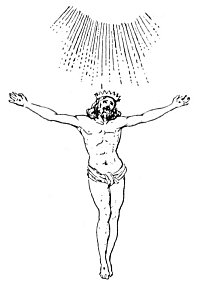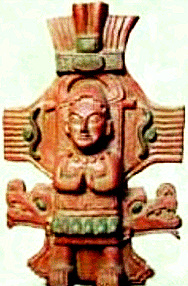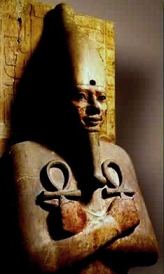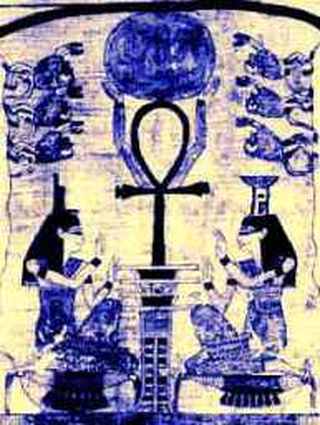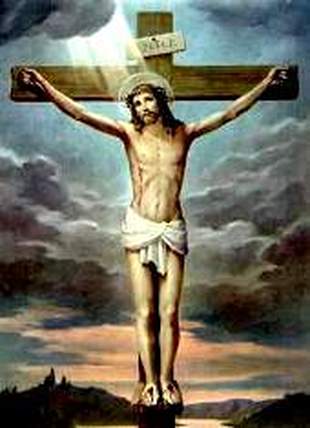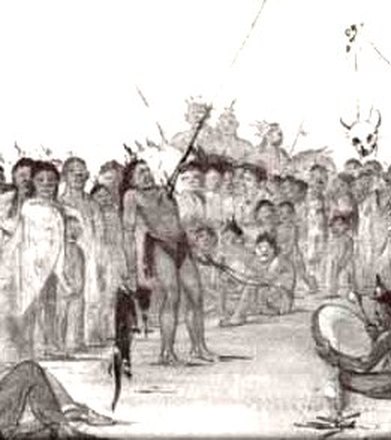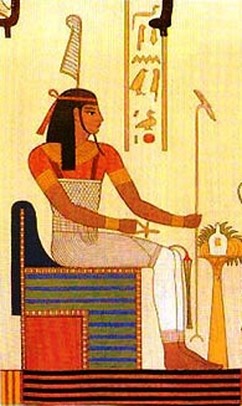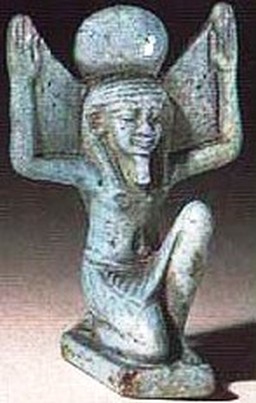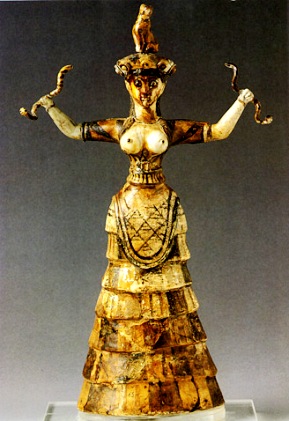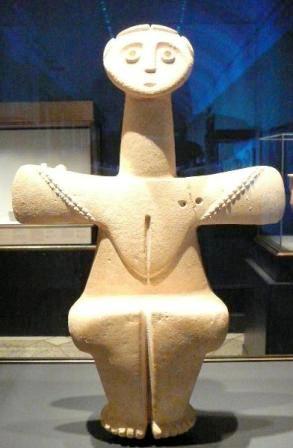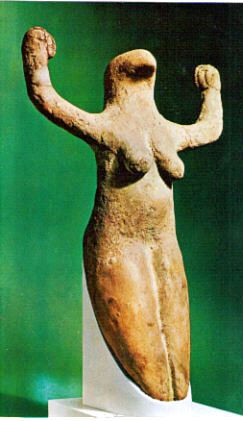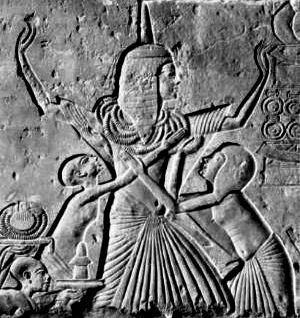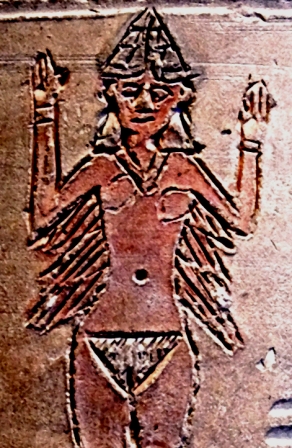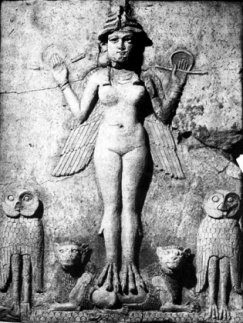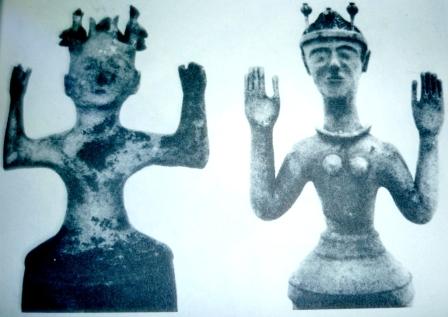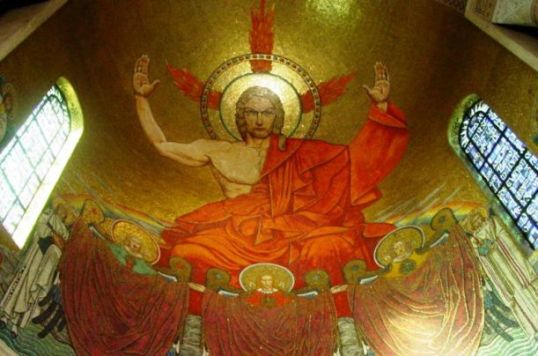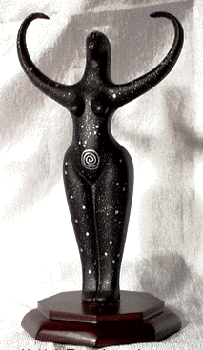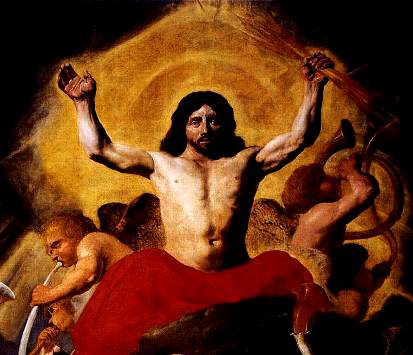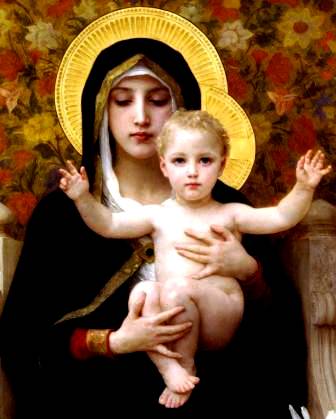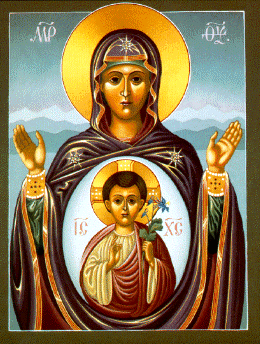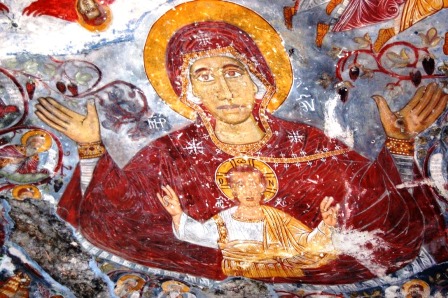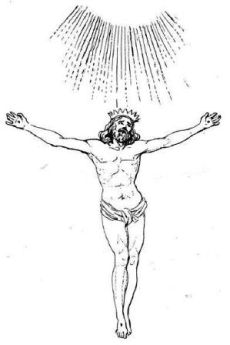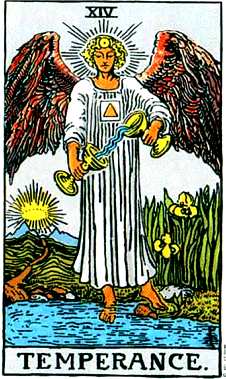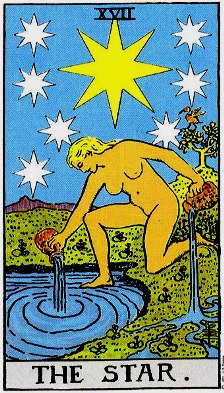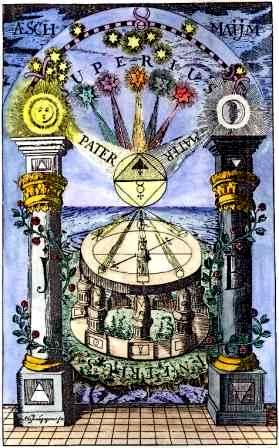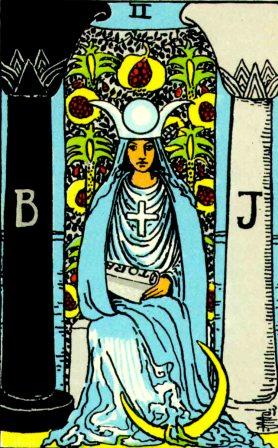
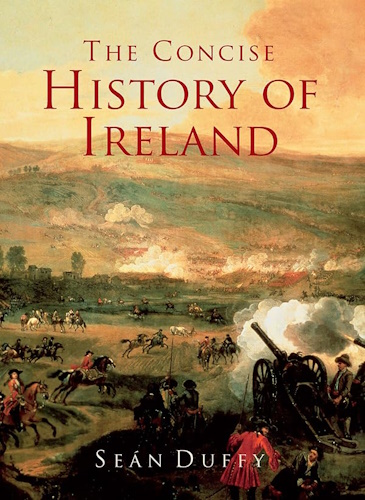
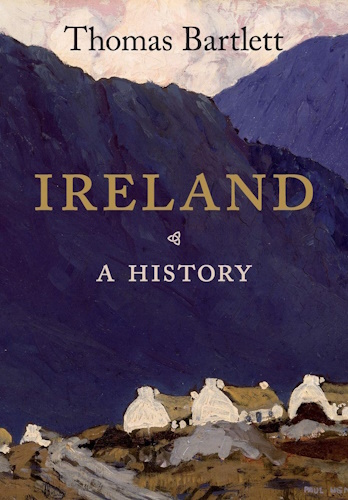
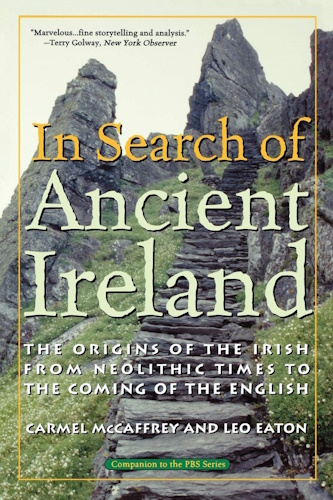


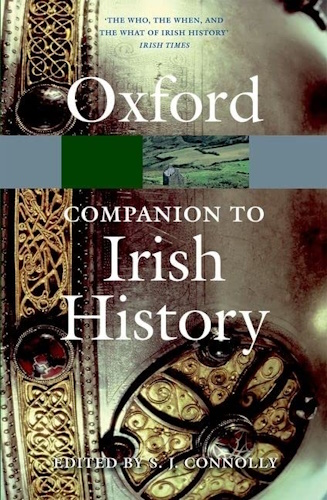
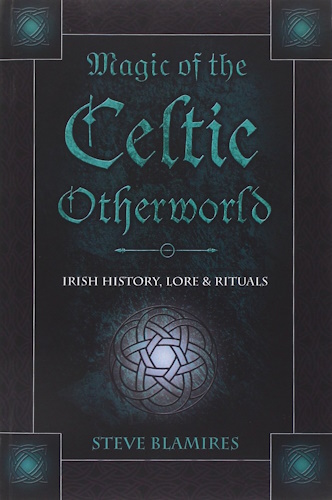


Druidic Symbolism
in
Masonry and Judeo-Christianity
Appendix I to Volume I
of
The Irish Origins of Civilization
by
Michael Tsarion
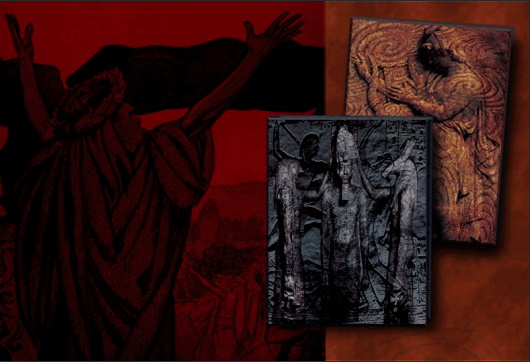
![]()
![]()
Origin of the Crucified Savior
Osiris and Horus were crucified as 'saviors' and 'redeemers;' the sufferings, death, and resurrection of Osiris forming the great mystery of the Egyptian religion. Prometheus, of Greece, was with chains nailed to the rocks of Mount Caucasus, 'with arms extended,' as a savior; and the tragedy of the crucifixion was acted in Athens 500 years before the Christian era - William W. Hardwicke (The Evolution of Man)
Below we see the Aryan Lord Vishnu with outstretched arms. He embraces and blesses the universe. In the center we see Quetzalcoatl (the "Feathered Serpent") on his cross. This god was described as being fair of complexion, that is tall, blond and blue-eyed. On the right we see a sculpture of Osiris holding two Ankhs or crosses of life. Osiris was a "crucified" god. He appears in the Gospels as Lazarus. His early nameWesir is very near to the modern word "West."
To the west, to the mansions of Osiris, To the west thou are going. Thou who were best among men, Who did hate the untrue - (Egyptian hymn to Osiris)
In Scandinavian mythology the god-man Odin hung himself upside-down upon Yggdrasil (the "World Ash Tree") to attain enlightenment. The symbolism we speak of and see here did not arise because of the dispersion of Jews and Christians. No, the same high symbolism is found the world over because of the migration of the Arya. Like Quetzalcoatl, they too were fair-complexioned and from the West.
The mythographers have used many excuses in an attempt to disguise the Egyptian and Druidic origins of their symbolism and iconography. Most of the stories and tales in the Jewish books and Old Testament have undergone heavy revision. The accounts of Pharez and Zarah, David and Goliath, Salome and the Baptist's beheading, forty days in the wilderness, Solomon and the two mothers, massacre of the innocents, and plagues of Egypt, for example, have each been given "the treatment."
LEFT: Lord Vishnu cruciform. CENTER: Quetzalcoatl on the cross.
RIGHT: A pharaoh with crossed arms and Ankh crosses.
LEFT: A humanly shaped Ankh or Crux Ansata with outstretched arms holding a solar disk. RIIGHT: We see the well known image of Jesus on the cross. We see the cross or crucifix and outstretched arms. The image of the divided or quartered god-man was known throughout the world thousands of years before the advent of Christianity. In the Egyptian rendering, we see two females (Isis and Nephthys) in close proximity to the cross. In the Christian rendering we see the two Marys (Virgin Mary and Mary Magdalene) at the foot of the cross. Most of what we read in the New Testament, from the Nativity to the Resurrection, has its origins in the Astro-Theological canon of Irish Druids and Egyptian Amenists.
Your feet are on the earth
Your head is in the sky
You stand up with the strength of your arms,
But your weight rests upon the secret
The sky is over you, the underworld beneath you,
The wind is the air in your nostrils
(Ancient Egyptian Hymn to Shu)
The Lakota Sun Dance ceremony was, to all intents and purposes, a "crucifixion." The candidate was raised into the air, his arms outstretched to embrace the cosmos. During the ceremony the candidate experienced the presence of the "Great Spirit." The idea of the circle and cross and of a ritual sacrifice was common throughout the Americas long before Christianity made an appearance. (In Mexico, the "Feathered Serpent" was seen in proximity to a cross.) North-American Indian tribes had elaborate annual rites with rich cosmological and Astro-Theological themes. Giant medicine wheels (representing zodiacs) were constructed on the plains. Some of these earthworks are approximately 10,000 years old. (Here for more.)
In the solar mythology, the sun god is regularly "crucified" as he crosses over the equinoxes and when he wanes towards the end of the year - D. M. Murdock (Christ in Egypt)
Osiris was represented as being stretched on the immense cross formed by the junction of the meridian and the equator. This deity was suspended in the Phrygian mysteries to a cruciform tree – Arthur Dyott Thompson (On Mankind: Their Origin and Destiny)
In all private religious associations and secret cults of later antiquity the members made use of a secret sign of recognition or union. This they carried about in the form, in some cases, of wooden, bronze, or silver amulets hung around the neck or concealed beneath the clothes, in others woven in their garments, or tattooed upon the forehead, neck, breast, hands, etc,. Among these signs was the cross, and it was usually described under the name "Tau" after the letter of the old Phoenician alphabet - Arthur Dewes (The Christ Myth)
...the non-Christians possessed crosslike sacred objects and revered their idols of gods in the shape of a cross or in cruciform. In fact, Tertullian is very insistent on this point, stating of the Pagans, "your religion is all cross" and "your gods in their origin have proceeded from this hated cross" - D. M. Murdock (Christ in Egypt)
A number of Egyptian goddesses are likewise depicted in cruciform, with arms and wings outstretched, found in tombs and commonly on coffins - ibid
...regarding the cross and the image of a god in cruciform - or the crucifix - William Williamson states: "The cross...is a symbol of the highest antiquity, but the representation of a figure with the hands and feet pierced with nails belongs to a later period. The most ancient delineation of the cruciform attitude is the figure of the god in the vault of heaven, with outstretched arms, blessing the universe - ibid
The ritual lamentation of the divine sisters, Isis and Nephthys, for Osiris...is found in the temple remains of the island of Philae expressly connected with the representation of Osiris in the form of a crucifix, the God's head standing on top of a four-barred Nilometer, faced by the mourning female figures - John M. Robertson (Christianity and Mythology)
Osiris has been found in this attitude. Also Vishnu as Witoba is presented as the crucified in what has been termed the crucifixion in space; the crucifixion without a cross, in which the god himself is the cross in a male form - Gerald Massey
Osiris was represented as being stretched on the immense cross formed by the junction of the meridian and the equator. This deity was suspended in the Phrygian mysteries to a cruciform tree – Arthur Dyott Thompson (On Mankind: Their Origin and Destiny
We have evidence from the pyramid of Medum (Meidoun) that from 6,000 to 7,000 years ago the dead in Egypt were buried in a faith which was founded on the mystery of the cross, and rationally founded too, because that cross was a figure of the fourfold foundation on which heaven itself was built - ibid
The symbol of the cross originated as part of an ancient Egyptian initiatory rite, and eventually found its way into Christianity. The church stated that in its history, 'there is no proof of the use of a cross until much later' than the Sixth Century. It is recorded in Christian archives that the general use of the crucifix was ratified at the Sixth Ecumenical Council in 680…The Council decreed that 'the figure of a man fastened to a cross be now adopted' and the new church logo was later confirmed by Emperor Hadrian I (772-95). About a century later, the first pictures of Jesus Christ standing against a cross slowly started to appear – Tony Bushby (Secret in the Bible
The attention of the writer having been called to the fact that all Indo-Germanic nations have worshipped crucified Saviours, an investigation of the subject was made. Overwhelming proof was obtained that the sun-myths of the ancient Aryans were the origin of the religions in all of the countries which were peopled by the Aryans. The Saviours worshipped in these lands are personifications of the Sun, the chief god of the Aryans. That Pagan nations worshipped a crucified man, was admitted by the Fathers of the early Christian Church. The holy Father Minucius Felix, in his Octavius, written as late as A. D. 211, indignantly resents the supposition that the sign of the cross should be considered as exclusively a Christian symbol ; and represents his advocate of the Christian argument as retorting on an infidel opponent thus: "As for the adoration of crosses, which you object to against us, I must tell you that we neither adore crosses nor desire them. You it is, ye Pagans, who worship wooden gods, who are the most likely people to adore wooden crosses, as being parts of the same substance with your deities – Charles Morris (Aryan Sun Myths)
Tertullian, a Christian Father of the second and third centuries, writing to the Pagans, says: "The origin of your gods is derived from figures moulded on a cross. All those rows of images on your standards are the appendages of crosses; those hangings on your standards and banners are the robes of crosses" – ibid
By the Sixth Synod of Constantinople (Canon 82), it was ordained that instead of the ancient symbol which had been the lamb, the figure of a man nailed to a cross should be represented. All this was confirmed by Pope Adrian I. (See Dupuis's Origin of Religious Belief, and Godfrey Higgins's Anacalypsis) - ibid
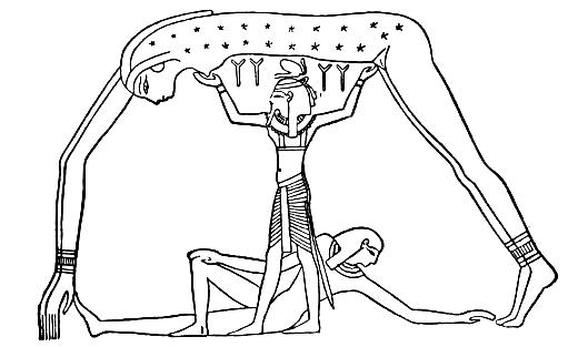
Shu, the Egyptian god of life. His arms are cruciform as he divides the heavens from the earth. He was the original "Crucified Savior." This god was based on the Aryan (Irish) Esus who was depicted in a similar fashion. The name Shu turns up in the Hebrew Joshua, which becomesYeshua, the Hebrew rendition of Jeshua or Jesus. This is comprehendible once we realize that the original Jews or Judites were Druids. It is Druidic or Aryan gods and ways that were adopted by Eastern races and nations. Shu was known as "the firstborn" and "the Lion." Jesus was known as the "Lion of Judah." Esoterically, this simply means "Jesus of the Judites or Druids," and not "Jesus the Jew," as we would normally think. In fact, the Welsh title for the Druids is Shaau, Suw or Shew. This is where the modern name "Shaw" originates. Shu is equivalent with the Christian "Holy Spirit."
Shu is one of the few male Egyptian gods to be shown with a human face. He was a member of the Ennead, or nine original creator gods. This Ennead appears in the Old Testament as the Elohim. Shu was part of the trinity of creator gods that included Atum his father and Tefnut his sister. He symbolized the element Air (Holy Spirit) and the space between heaven and earth. He is commonly depicted with his arms raised or spread in the shape of a cross. In pre-Christian times, the crucified god was himself the cross. He was the "quartered one."
He is cryptically referred to in the Book of Genesis. When we hear of Jehovah putting enmity between the serpent and the woman, this relates to the Egyptian god Ra who sent Shu to separate the lovers Geb and Nut. Most of the Book of Genesis is based on Sumerian and Egyptian antetypes. The Heliopolitan mystery schools had a plurality of gods and goddesses, a Tree of Life, sacred river, paradisaical garden, and so on. The supreme deity of Heliopolis was Atum, from which we derive the name Adam.
Who Were the Canaanites?
During this century, the understanding of Yahweh has been shaped strongly by the study of Canaanite deities - Mark S. Smith (The Early History of God)
Despite the long regnant model that the Canaanites and Israelites were people of fundamentally different culture, archaeological data now casts doubt on this view. The material culture of the region exhibits numerous common points between Israelites and Canaanites in the Iron I period (ca. 1200–1000 BC). The record would suggest that the Israelite culture largely overlapped with and derived from Canaanite culture...In short, Israelite culture was largely Canaanite in nature. Given the information available, one cannot maintain a radical cultural separation between Canaanites and Israelites for the Iron I period - ibid
In Appendix XIII I deal with the problem of words and names and how they have suffered at the hands of mythmongers and deceivers. Here I emphasize the deception that concerns the words Canaan and Canaanite. Officially, the name Canaan denotes a geographical location and a person, namely, the grandson of Noah. This so-called Canaan is, by way of his own son Sidon, allegedly the father of many tribes, namely, the Jebusites, Hivites, Arkites, Girgashites, Zemarites, Amorites, Sinites, Arvadites, and Hamathites. One obscure legend decleres Canaan to be the father of the Black-skinned nations of Africa, such as the Sudanese and Nubians.
As to place, Canaan defines a region that encompasses today's Israel, Palestine and Lebanon, as well as part of Jordan, Syria and North-Western Egypt. In other words, after the sixth century BC, the land of Canaan was renamed Judea, and then after the arrival of the Romans the name was changed again to Palestine. In ancient accounts the word is usually spelled with a "K" as in "Kana" or "Kanan." Like the words Kohen and Cain, it means "Serpent Priest." We recognize this as a nomen denoting the ancient Aryan elders. The land of Canaan has long been associated with the ancient Phoenicians or Acadians, a ground that, in my estimation, originated in the Western hemisphere.
Before the time of the so-called Israelites, Canaan was part of the Akkadian Empire (circa 2300 BC). It was also home to the Amarru, Martu or Amorites. Later it was home to the Hurrians. It may also have been frequented by the mysterious Luvians or Luwians whose traditions were later to be found among the so-called Old Testament Levites. The place was also visited and frequented by Tyrians and Philistines. By the second millennium BC, Canaan fell to the Egyptians, although during the reign of the Hyksos Kings (Seventeenth Dynasty), it was divided into districts ruled over by semi-independent governors.
The Hebrew patriarch Abraham and his wife Sarah allegedly entered into the land of Canaan at the direction of the Lord. They entered the land from outside of it, and took it for their inheritance.
Get out of your country, from your family and from your father's house, to a land that I will show you - (Genesis 12:1)
Then the Lord spoke to Moses, saying, "Command the children of Israel, and say to them: `When you come into the land of Canaan, this is the land that shall fall to you as an inheritance" - (Numbers 34:1-2)
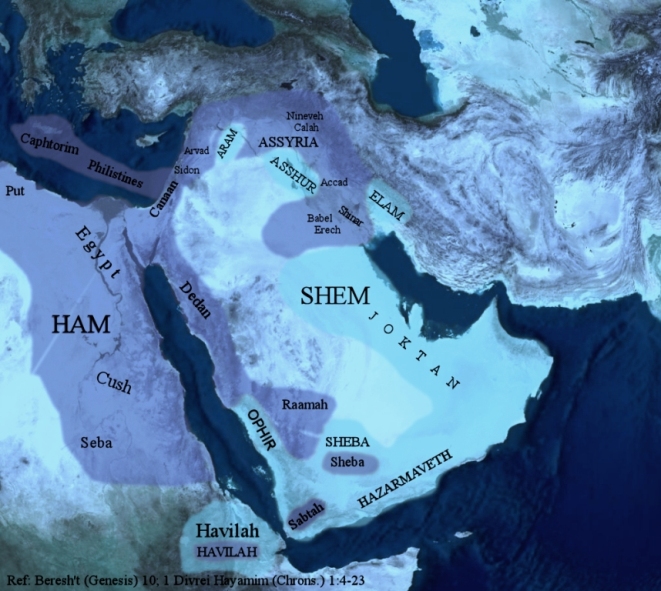
Things become rather complicated when we discover that the term Canaanite, as it has been used in the Bible, may be misattributed. It may not refer to a people located in the region shown on the map above, and, furthermore, may not even refer to the region shown. In other words, as we've shown in Appendix XIII, it is likely that this ancient term, referring to the Serpent Priests and their knowledge, was, like so many terms and titles, appropriated by the mythmongers and deliberately misconstrued.
In his work The Origins of Biblical Monotheism: Israel's Polytheistic Background and the Ugaritic Texts, Mark S. Smith explains the the nature of the main problems besetting students of Canaanite history:
Despite the widespread scholarly use of the term "Canaanite," I want to warn readers that I have largely avoided it...It is a misleading term that often clouds analysis. In the current scholarly environment, it is impossible to escape the debate over the relations between "Canaanite," "Ugaritic," and "Israelite," as well as "Amorite." The labels "Ugaritic" and "Canaanite" have been a matter of discussion since the discovery of the Ugaritic texts. In the 1960s, A. Rainey argued that Ugaritic is not Canaanite, because one Ugaritic text refers to a Canaanite with other foreigners, specifically an Egyptian and someone from Ash. Rainey also cites an Akkadian text from the site of Ugarit that refers to "the sons of Ugarit" and "the sons of Canaan." Following Rainey's lead, D. R. Hillers has suggested that the Ugaritic texts cannot be used to establish a Canaanite culture with which to compare developments in Israel. The denial of the equation of Ugaritic and Canaanite is correct, strictly speaking, but on the basis of linguistic criteria it is possible to defend a strong relationship between the two...Preferring the term "West Semitic" to "Canaanite..."
Smith continues to write on the problem, getting to the crux of the matter in the following passages:
N. P. Lemche goes farther than Rainey or Hillers. He disputes Rainey's arguments that Ugarit was not part of Canaan. According to Lemche, one letter from the king of Tyre (EA 151) includes Ugarit in the land of Canaan; yet Rainey has seriously questioned this interpretation. There is the further issue of the historical significance of the term "Canaanite." Lemche argues that "Canaanite" never appears in records used by "Canaanites" themselves: "to the scribe of ancient Western Asia 'Canaanite' always designated a person who did not belong to the scribe's own society or state, while Canaan was considered to be a country different from his own."
Lemche sees the biblical use "Canaanite" as an artificial construct largely deriving from the postexilic period. Lemche takes the conflicting descriptions of Canaanites in biblical and other Near Eastern texts as evidence that no such people or culture existed. In effect, Lemche relies on an argument from silence. Moreover, Lemche claims: "The Canaanites of the ancient Near East did not know that they were themselves Canaanites."However, it seems odd to suppose that foreign courts from Egypt to Hatti to Mesopotamia used the term "Canaanite," but the people whom others designated with this term never knew themselves by it. Perhaps this term did not function as the primary self-designation of people from "Canaan" (perhaps their individual clan units, cities, towns, or sub-regions were the primary self designations)
What are we to logically conclude from these statements about the Canaanites? Might we not be correct to dismiss the racial question, realizing instead that the term denoted not a specific nation or group, but rather a caste of wise elders. Might these not be the Luvians or Serpent Priests whose origins lie in the West?
. . .
WHAT THE ARTISTS REVEAL
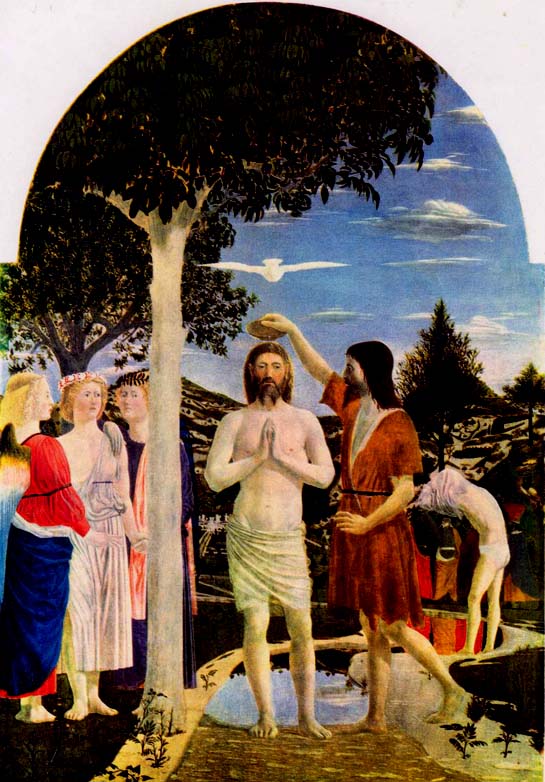
Baptism was not known among so-called "Jews." It was, however, known to Amenists, Druids and other ancient adepts. Washing or bathing in the sacred river was primarily associated with the goddess tradition and was a feminine initiation rite. For example Hera, the consort of Zeus and supreme goddess of the Greeks, bathed herself yearly in a river in order to restore her purity or divine "virginity."
The artist depicts the dove, river, and tree. On the right stand three figures. The number three represents the Druids. The artist knew what most Christians are not meant to know about their all too pagan religion. The river may represent the constellation Eridanus. It may also represent the Milky Way that runs between Gemini and Sagittarius. In this case, Jesus and John would represent the "Twins" of Gemini.
For washing in the channel through which the heathen are initiated into some sacred rite - of some notorious Isis or Mithras. The gods themselves likewise they honor by washing - Tertullian (On Baptism)
The use of lustral water is found among the Babylonians, Assyrians, Egyptians, Greeks, Romans, and others - Catholic Encyclopedia (Baptism Entry)
...all religious ceremonies of Pharaonic times, whether performed on behalf of a deity, a deceased noble, or the living king, were prefaced by some act of ritual cleansing - Dr. Richard A. Gabriel (Gods of the Fathers)
Two cards from the Tarot's Major Arcana. The card on the left represents the sign of Sagittarius. The card on the right represents Aquarius. In each image the figures have one foot on land and one foot in water. (Compare this to the figure of Christ in the painting above.) The figures below represent Sagittarius and Aquarius. The former sign comes after the water sign of Scorpio and before the Earth sign of Capricorn. The latter sign comes after the Earth sign of Capricorn and before the Water sign of Pisces. The artist has subtextually referenced the astrological position of the two signs in an idiosyncratic manner. In other words, the images are laced with occult facts discernible only to initiates of the mystery traditions. The situation is no different when it comes to Judeo-Christian iconography and scripture.
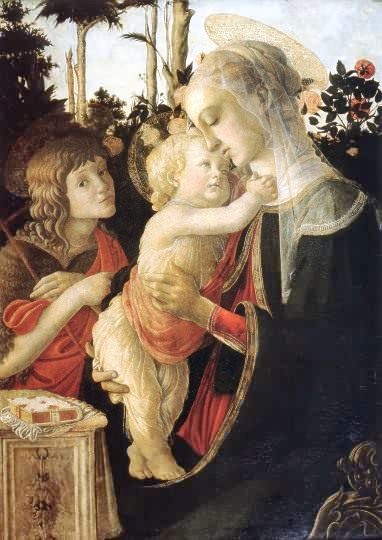
The Madonna, by Sandro Botticelli. Note how the youthful John the Baptist gazes out toward the viewer. His arms are suggestively crossed on his breast in the manner of Egyptian gods and pharaohs. This is no surprise, once we understand that John the Baptizer was based on Anubis the Baptizer. As authors such as Picknett and Prince have discovered, it is John the Baptist who was the prophet chosen as tutelary master by secret societies such as the Freemasons and Knights Templar. This is the reason why many Renaissance artists (such as Botticelli in this instance) portrayed John holding the cross, not Jesus. (For more on the Jesus and John controversy, refer to The Templar Revelation, by Picknett and Prince, and Volume Two of The Irish Origins of Civilization.)
Anubis is also the messenger of the gods, equivalent to the Greek god Hermes or Mercury, the counterpart of Egyptian lunar god Thoth...Moreover, like Those, whose emblem is the Tau or T, Anubis is "never without a cross," specifically the life-giving ankh, one of the holiest symbols in Egyptian religion..."The cross with a handle which Tot holds in his hand was none other than the monogram of his name" - D. M. Murdock (Christ in Egypt)
...in the version by Church father Hippolytus...the Aeon Horus is called by his "primary title," Stauros, meaning "cross." Hence, in ancient times - during the second century, precisely when Christianity was finding its footing - there existed in Egypt the concept of Horus as the Cross personified - ibid
The pillars seen in front of large buildings represent trees. The pilasters on top of many columns frequently bear floral motifs. On the right, we see Arcanum II of the Tarot's Major Arcana. The pillars bear the letters "J" and "B," which stand for Jakin (Jachin) and Boaz. The columns also bear floral motifs. The black and white coloring represents the banks of the Nile. On one bank, the black desert, on the other, the white desert. These two banks are also represented by the numeral of this card - II. The Priestess depicted represents Isis, the goddess associated with the Nile. Note how her blue dress flows like water. Behind Isis is the tree of life, bearing pomegranates. These fruits symbolize the "underworld," and the sacred mysteries protected by the body of the goddess. In the baptism painting above, we see the tree and the sacred river. Trees were sacred to the Arya, or Druids, and so was the river. Therefore, whenever we encounter trees and rivers in Jewish, Christian , or Masonic iconography, we understand that they are plagiarized and cannibalized motifs.
The name of the Canaanite goddess Asteroth means "sacred tree," although this translation is redundant because all trees were sacred to the ancient peoples of the Near East and Europa - John Lamb Lash (Not in His Image
"The groves were God's first temples," says Bryant. The groves, too, were among man's first gods...Not only the Druids of Britain, but the Greeks, and the Semitic races of Asia were worshipers of trees. The giant oaks and the symmetrical evergreens were gods..."The worship of trees," says Soury, "only disappeared in Syria at a very late date...The largest and tallest trees, and the evergreen ones, were adored as gods – John E. Remsberg (The Christ)
In Ireland certain very famous trees, usually yew trees, were closely connected with the tribes in whose territory they stood. They were held as sacred, and served as tribal meeting places. This custom was pagan in origin, but the trees continued to be held in reverence in Christian times. When Christianity was introduced, pagan sacred sites were often converted into Christian sacred sites – Alexander Stewart (A Highland Parish or the History of Fortingall, 1928)
In the religious history of the Aryan race in Europe the worship of trees has played an important part. Nothing could be more natural...From an examination of the Teutonic words for "temple" Grimm has made it probable that amongst the Germans the oldest sanctuaries were natural woods...tree worship is well attested for all the great European families of the Aryan stock – Sir James George Frazer (The Golden Bough, 1922)
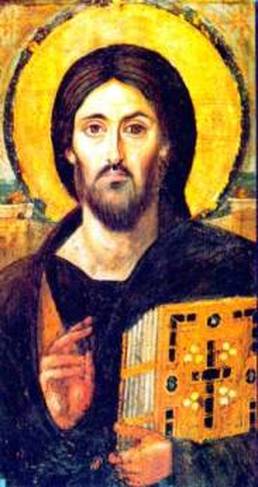
Christ with solar halo and book. He makes the sign of the goat. The raised two fingers originally symbolized the "horned one." This did not signify something evil. It simply denoted the great stag god Herne. Place names such as Cadiz, Aegean, Golgotha and Giza mean "Place of the Goats" or more correctly "Goths," that is the Arya from the West. Jesus was based on the Gothic or Irish Iesa (Esa). Other European gods such as Orpheus, Dionysus and Bacchus were based on this Western antetype.

The Adoration, by Domenico Ghirlandaio. The figure of the Virgin Mary represents the night sky. The artist suggests the round of the zodiac by the circular hem of the Madonna's cloak. Christ is the sun born in the sign of Virgo, the Virgin. Joseph, the "Carpenter," looks up toward the heavens. He is contemplating the signs and represents the ancient gnosis suppressed by the Church of Rome. The three animals present represent signs of the zodiac. The bull represents Taurus (and the Amenists and Druids), the ass represents Cancer; the lamb represents Aries (and the Atonists). The arched portal on the left of the canvas cryptically signifies Druidism. The word druid means "doorway" or "portal." It gives our modern "door." Indeed, this is what the words pontifex (signifying the pope) and cardinal also mean. The fact that one of the three visitors holds a lamb indicates that they are members of the Solar Cult, and probably Atonists. The blatant Romanesque motifs (of archway, Corinthian pillars, fallen column and marble altar) were added by the artist to signify where the Bible story depicted was truly composed. It was not in Judea or Galilee.
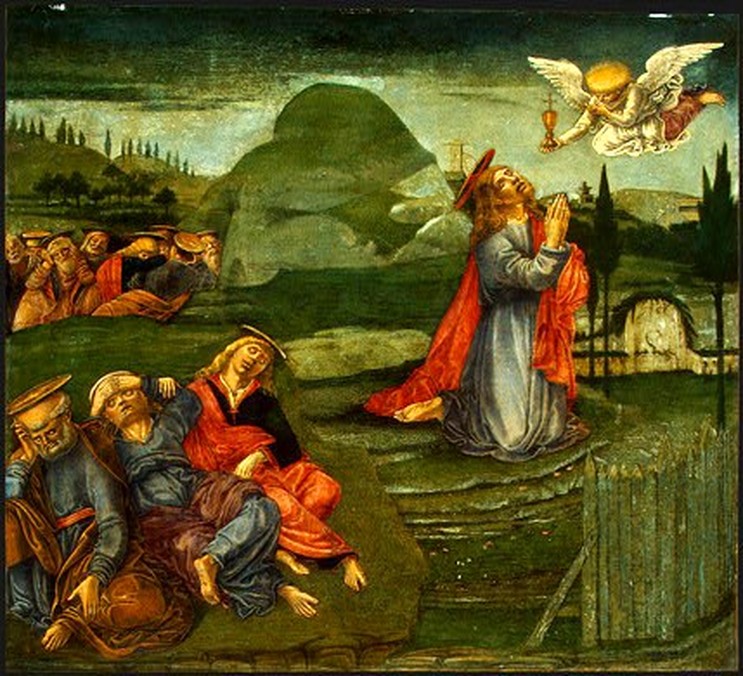
Many Medieval and Renaissance paintings depicting events from the scriptures feature a mount or high place in the background. This artist has chosen to place the mount centrally on his canvas. This motif is purely Druidic, as is the motif of the sacred garden or, more correctly, grove.
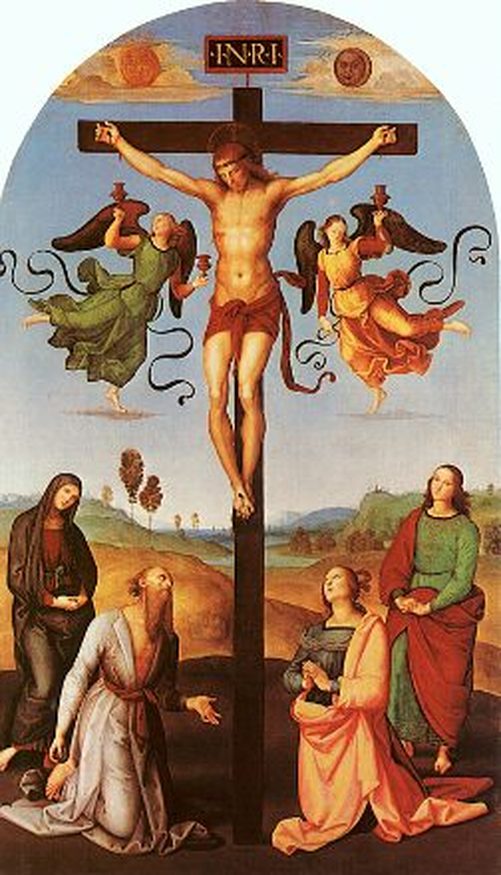
This artist has placed the luminaries (the sun and moon) on either side of the crucifix. This brings out the Astro-Theological elements in the story of the crucifixion. Could the four attendees at the foot of the cross then represent the four cardinal points of the zodiac? Could the strange letters above Christ's head be the first letters for Iammim, Nour, Ruach and Ibeshah, or Fire, Water, Air and Earth? Is Jesus the fifth element? For more on this subject, see my book Astro-Theology and Sidereal Mythology.
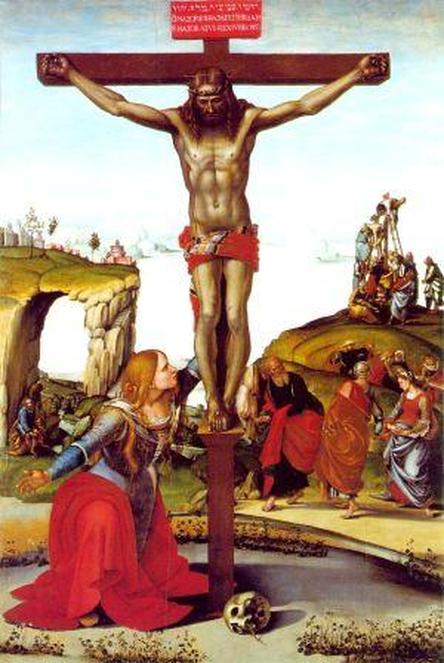
The Crucifixion, by Signorelli. A red-haired Mary Magdalene mourns at the foot of the cross on Skull Hill. A mound and and a portal are seen in the background. A skull lies at the foot of the cross. The skull denotes the Merovingians, Templars, Cistercians and Culdeans, and hints to the viewer that the painting contains esoteric motifs understandable only to those men initiated into the Mysteries. Mary's distinctive red hair connotes her Western origins as well as the Western origins of Biblical lore. Red hair was the distinguishing mark of Scythians and Merovingians. The Bible's convoluted texts were composed by scribes in the pay of the Merovingians and Templars, that is, of the Atonists.
The Galatians of the New Testament were blond, blue-eyed Celts. An apocryphal
legend claims that John the Baptist was a Celt, and Mary Magdalene was Circassian,
half Celtic, half Jewish - J. Lash (Not in His Image)The ever-important Isis was in fact one of these goddesses known by the title
Meri/Mery...That goddesses were beloved or Mery is obvious from an enigmatic
spell...that invokes "the Goddess greatly beloved with red hair" or "Her who is greatly
beloved, the red-haired" - D. M. Murdock (Jesus in Egypt)
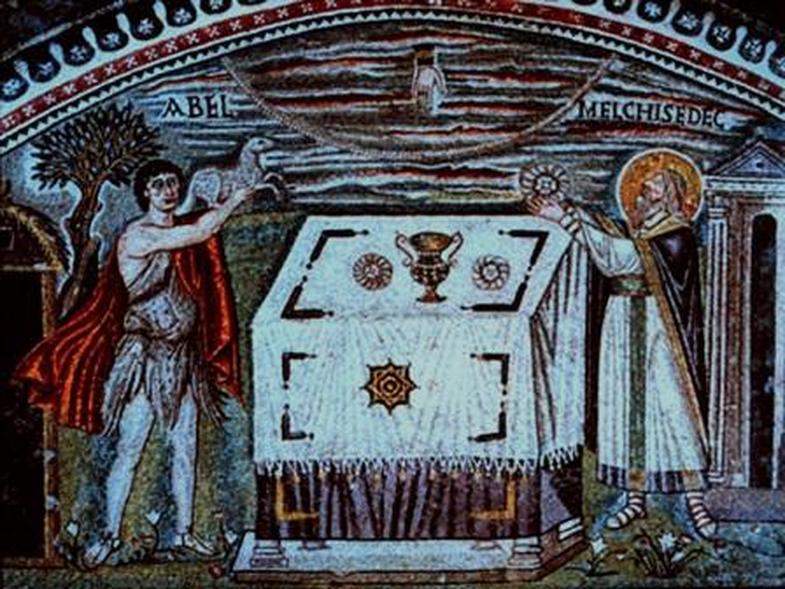
As with so many Biblical characters (Enoch, Abraham, Noah, David, Solomon, Joseph of Arimathea, Lazarus, Mary, Jesus, and so on), Melchizedek was based on the archetype of the Druid. Note the artist's incorporation of the tree and portal, which cryptically refer to Amenism and Druidism. Melchizedek is traditionally connected to the Tribe of Shem, which was made up of fair-skinned types. The word Shem is, however, probably a poor rendition ofKhem, meaning Egypt, or of Shmn, meaning Hermopolis, the great city in Egypt. I believe Melchizedek, as he appears in the Bible, truly signifies Pharaoh Akhenaton, king of the Atonists. It might even signify Aton himself. As such, it serves the same purpose as the name Moses. And just as it is clear that there was no such man as Moses, as portrayed in the Old Testament stories, so we can assume there was no such entity as Melchizedek, as the Bible portrays him. Both fictive characters serve as place-holders for another who is not named. Those initiated into the mysteries, the higher members of the Church and the secret societies, know who is signified by these and other pseudonyms. In the painting, the figure of Melchizedek bears a solar halo and holds what appears to be a sun symbol, but which is, according to the Bible, an offering of bread. Abel holds the lamb which symbolizes Aries, the sign most sacred to Atonists. The central table is designed to appear like a cube. It is the ashlar, or altar,of Masonry. The ninety-degree "rules" at the base of the "table" also signify the Masonic fraternities.
- For more on Melchizedek, see Volume Two, Chapter Eight: The Dead Sea Scrolls.
Hiram Abiff (Builder of Solomon's Temple)
Druidism itself was known in ancient Britain as "Y Maen" - the stone religion, or "The Stone Kingdom." Let us also remember that Zion also means "Stone;" Mount Zion is "the mount of stone" - Fredrick Haberman
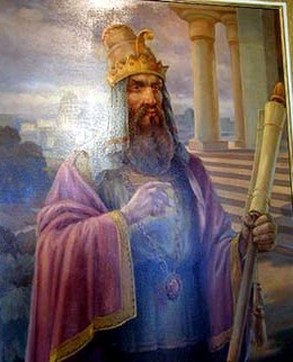
As mentioned above, Christian scriptures are replete with Druidic leitmotifs. If anything makes such texts "holy," it is the plagiarized elements belonging to the noble elders of old.
Naturally, without a study of how the Druidic symbolic motifs were cannibalized and finally incorporated into the Christian canon, one is sure to misunderstand my theory concerning the dark origins of Judeo-Christianity and Masonry. However, in my opinion the symbolism serves to tell the tale and to expose the level of perfidy of these wholly corrupt institutions.
One Druidic motif concerns the famous Old Testament character referred to as Hiram Abiff. He plays a prominent role in Freemasonry, and was accepted by Jews, Christians and Masons as one of their most illustrious spiritual ancestors. Allegedly, he was the builder of the Temple of Solomon.
As to so-called Druidical monuments, no argument can be drawn thence, as to the primary seat of this mysticism, since they are to be seen nearly all over the world – James Bonwick (Irish Druids and Old Irish Religions, 1894)
Newgrange (in Ireland) is the oldest scientific instrument in the world still functioning. It predates Stonehenge and the Pyramids, and stands as one of the world's most ancient monuments. It is quite likely it will still be functioning when our own scientific instruments have turned to dust – Martin Brennan (Lecture on Newgrange Tumulus)
The earliest people inhabiting Celtic territory in the West of Europe of whom we have any distinct knowledge are a race without name or known history, but by their sepulchral monuments, of which so many still exist, we can learn a great deal about them. They were the so-called Megalithic People, [from Greek megas, great and lithos, a stone] the builders of dolmens, cromlechs, and chambered tumuli, of which more than three thousand have been counted in France alone. Dolmens are found from Scandinavia southwards, all down the western lands of Europe to the Straits of Gibraltar, and round by the Mediterranean coast of Spain. They occur in some of the western islands of the Mediterranean, and are found in Greece, where, in Mycenae, an ancient dolmen yet stands beside the magnificent burial-chamber of the Atreidae. Roughly, if we draw a line from the mouth of the Rhone northward to Varanger Fiord, one may say that, except for a few Mediterranean examples, all the dolmens in Europe lie to the west of that line. To the east none are found till we come into Asia. But they cross the Straits of Gibraltar, and are found all along the North African littoral, and thence eastwards through Arabia, India, and as far as Japan - T. W. Rolleston (Myths and Legends of the Celtic Race, 1911)
Of course I doubt that such a temple existed, at least as the Testaments portray it. I am more inclined to agree with investigators who speculate that the temple was the great pyramid at Giza. I stress, however, that the term "Solomon" was the title for the highest class of solar priests and, like Moses, Aaron, David, Joshua and Jesus, it was bestowed upon several individuals. It denoted both the physical sun as well as spiritual enlightenment. It denoted men who attained mastery of the high arts.
Astro-Theologically speaking, the so-called "Temple of Solomon" was simply the zodiac, the place of "many mansions." I believe the mythmongers used many cover terms for the zodiac. Here are a few that were used as references to the heavenly temple:
City of David
Gates
Celestial City
Throne of the Elect
Mount Zion
Seat of Judgment
Wilderness
Bottomless Pit
Heaven or Hell
Grotto
Oracle
Tomb
Labyrinth
Tabernacle
New Jerusalem
Nazareth
Bethlehem
Hall of Judges
Kingdom of God
Tent of God
Flocks by Night
Aeons / Ages
Seasons
Mansions
Citadel
Seven Churches
Mount of Olives
If the Temple was so spectacular and so wealthy, why did Herodotus not bother to go there? Why did the knowledge seeking Alexander the Great when in the area, not bother to go there, even for the plunder? - Ernest Busenbark (Symbols, Sex and the Stars)
Clearly, Hiram was the sun and not an individual per se. I believe the name was most probably used as a title for the chief astrologers and astronomers whose temple was the heavenly zodiac. Given that earthly shrines and temples were geographically and geometrically based on the various constellations and luminaries of the zodiac, it is not far-fetched to suppose that the Temple of Solomon was the cosmic temple which encircled the heavens above men's heads, and in which the "gods" resided.
Elements found in the story of the life and death of Hiram lead us to believe the story to be largely Astro-Theological in nature.
...this whole affair of which we speak and preach, and which is called Gospel, has no reference at all to any person that ever existed, or events that ever occurred upon earth, but it is astronomical – Rev. Robert Taylor (The Devil's Pulpit)
…King of Heaven, prince of Creation, sun of the eastern sky who appeared both to the dead in Hades and to the mortals upon earth he, the only true Helios, arose for us out of the highest summits of Heaven - Melito of Sardis (Second Century Theologian)
The name Hiram Abiff has interesting etymological origins. Abiff may derive from Abi, meaning "master," "father" or "elder." In other words, the supposed characters was a master of something.
According to Philip Gardner, Hiram may derive from Hir, meaning "head," or "exalted," andAm, meaning "people." In this instance the name would be similar in meaning to Abraham, which can be rendered Ab Hir Am, meaning "Father Head of the People." It may also derive from Ahi Ram, meaning "Head Snake" or "Exalted Serpent." In this instance it would be similar in meaning to Pendragon, meaning "Head of the Dragons."
There is also evidence indicating that the term "Hiram" was used by the Bible's mythmongers to obliquely refer to the Druids or, more specifically, to their highest degreed elder, the grand master of building, navigation, astronomy, language and magic. It is acknowledged by historians and Masonic writers that Hiram was of the "Phoenician" race. And since the Phoenicians (or more correctly the Arcadians) were elders from the British Isles, it follows that Hiram the Elder, if he existed, was a member of the Arya. It implies, more correctly, that "Hiram Abi" was yet another title referring to the chief among the Arya or Druids. Given the superb temples which fill Egypt, most of them erected by Amenists, we can certainly conclude that there was, among the people and their leaders, the deepest awe and respect for the master architects.
The Druids taught the existence of one god, to whom they gave a name "Be'al," which Celtic antiquaries tell us means "the life of everything," or "the source of all beings," and which seems to have affinity with the Phoenician Baal. What renders this affinity more striking is that the Druids as well as the Phoenicians identified this, their supreme deity, with the Sun - Thomas Bulfinch (Bulfinch's Mythology, Chapter XLI)
The Druids had also their high places, which were large stones or piles of stones on the summits of hills. These were called Cairns, and were used in the worship of the deity under the symbol of the sun - ibid
...the Roman writers admit that "they paid much attention to the order and laws of nature, and investigated and taught to the youth under their charge many things concerning the stars and their motions, the size of the world and the lands, and concerning the might and power of the immortal gods" - ibid
…in the very oldest monuments of the Druids, we have the circle of stones, in the number 12, the signs in the circle - signs of the zodiacal circle, with the arch of heaven for the cupola; and, in fact, the divisions of the heavens marked in a great variety of ways - Godfrey Higgins (Anacalypsis)
The Kelts placed pillars on the tops of their hills, many of which are still visible. The pillars were dedicated to the Sun-god, Bal, or Bel, identical with Hu or Huan of Wales, and with Aedh...Many upright stones, pillars and uncut monoliths are to be seen in India...Bringing the stone, often from a great distance, sometimes from the Himalayas, no doubt on account of their great sanctity...The stones are usually roughly cut, like those which one sees so frequently standing in fields in Wales and Cornwall - Dorothea Chaplain (Matter, Myth, and Spirit or Keltic and Hindu Links)
Repeated references are made in the Bible to phallic idols, images, and worship, but they have been so thoroughly disguised in translation that they give the average reader no understanding of the beliefs and practices to which they refer. Many of the names of people and places mentioned also have a phallic significance, which is not revealed in the standard Bible Concordances - Ernest Busenbark (Symbols, Sex and the Stars)
In short, if a Hiram existed, I surmise that he was certainly one of the following:
A Phoenician
A Scythian
A Chaldean
A Persian Magian
A Druid
In every case (given the researches of this author, and of others in the last decade and a half) Hiram's ancestry would have been Irish. He was one of the Arya, and a member of the Serpent Brotherhood which kept the secrets of geometry, geomancy, astronomy, temple design, and so on. Indeed the Bible, in it's characteristically veiled manner, lets us know that this was the case. 2 Chronicles (2:11-14) tells us that Hiram was a member of the Tribe of Dan. The Tribe's emblem was the serpent. Author Barbara Walker emphasizes the Western origin of the Danites:
Writers of the Old Testament disliked the Danites, whom they called serpents (Genesis 49:17). Nevertheless, they adopted Dani-El or Daniel, a Phoenician god of divination, and transformed him into a Hebrew prophet. His magic powers were like those of the Danites emanating from the Goddess Dana and her sacred serpents…Daniel was not a personal name but a title, like the Celtic one - (The Woman's Encyclopedia of Myths and Secrets)
Her point, and ours, is strengthened by Philip Gardiner, author of Gnosis: The Secret of Solomon's Temple Revealed. Gardiner's presents intriguing facts about Hiram and the Irish (or Aryan) connection. The most intriguing reference concerns Hiram and the symbol of the serpent. The serpent was the symbol of the ancient Dragon Court and of the Irish Druids (the Adders, Naddreds or Pendragons). It also served as the universal symbol for wisdom and royalty.
There are more real links between Hiram and the serpent. For instance, we noted above that he was of the Tribe of Naphtali. The standard of the Tribe of Naphtali, according to Jewish tradition, is a serpent or basilisk and this could have come from Egyptian origins, as Jewish tradition states that Naphtali was the brother of Joseph, chosen to represent the family to Pharaoh – Philip Gardiner (Gnosis: The Secret of Solomon's Temple Revealed)
…Hiram is said to be a son of the Tribe of Dan and even the tribe of Dan had an emblem, which was amazingly also the serpent, this time with a horse – ibid
According to Rabbinical teaching the prefabrication of the Temple was performed by the Shamir, a giant worm or serpent that could cut stones (incidentally worm means serpent). Not dissimilar to Norse and Celtic beliefs where Valhalla and Camelot were built with the fire of the dragon and in China where building is aided by the serpent energy – ibid
Hiram Abiff: The Widow's Son
Hiram was referred to as a "Widow's Son." This anecdote refers to the heavens. In this case Hiram would be the sun, and the widow, his mother, the supreme goddess of heaven, known as Apt, Taurt, Nuith, Isis, Venus, etc. Moreover, the term "widow" can refer to the Irish goddess Eri. Simply, it is an arcane allusion to the earliest of goddesses.
Hiram is described in the Book of Chronicles as the son of a woman of the daughters of Dan.Christians are bound to think this refers to the Israelite Tribe of Dan. But we might ask if there is there something more to the term? Additionally, was there some significance to the Tribe of Dan having a serpent for their clan symbol? I think there is indeed a good reason, one which has to do with Druidism. Not only are the names of the twelve so-called Tribes of Israel Irish names, but the various emblems of the tribes originate with Druidism. The root dan(and related roots such as don, dona, adon, and dun, etc) can, for instance, be found throughout the world. It is particularly conspicuous in regions frequented by "Celts." It originates with Danu, a prehistoric Irish deity and one of the most prominent goddesses known. Her name can also be rendered Anu, or Ana. In this form the name turns up among the Babylonians and Sumerians. The name connotes the heavens. This is one reason why the serpent was a symbol for the Danites. The serpent is Draco of the zodiac. Draco figuratively guards the northernmost stars, those considered most sacred to ancient astrologers. The great cosmic serpent was, however, a symbol for the female. The Egyptian hieroglyph denoting female goddess was a serpent = a cobra with the title "Lady of Magic." In light of this, there can be little doubt that the Danites, referred to as Israelites, were really astrologers, that is,Arya.
Hiram is said to have hailed from the great Phoenician city of Tyre. But this city bears an Irish name. Tyre and Tara both derive from the name of Eri. And, as stated above, Eri's name was the origin of the name Ireland. Eri is the Hera of the Greeks. Her name is still preserved in words such as terra and terrestrial, denoting the earth.
Hiram and Osiris
From the midst of chaos was born Osiris, and at his birth a voice was heard proclaiming − "The ruler of all the earth is born"...Osiris traveled over the whole world, and civilized its inhabitants, and taught them the art of agriculture. But on his return to Egypt the jealous Typhon laid a stratagem for him, and in the midst of a banquet had him shut up in a chest which exactly fitted his body. He was nailed down in his prison, which cast into the Nile floated down to the sea - W. Winwood Reade (The Veil of Isis, or Mysteries of the Druids, 1861)
Hiram has also been associated with Osiris. A comparison of the myths of these two figures reveals many similarities:
Both went to foreign lands to share their knowledge of arts and sciences
In both legends there is a precious thing possessed: Hiram has the secret word; Osiris has the kingdom
In both legends there is a wicked conspiracy by evil men to seize the precious thing
In both legends there is a struggle and a murder of the virtuous leader
Both are murdered by their brothers (Osiris by Typhon; Hiram by Jubelum, his brother Mason)
Both bodies are buried hastily, with the intention of a later, deliberate burial
Locations of the bodies are both marked by Acacia at the head
In both legends, there are two separate searches for the bodies
In both legends there is a loss of something precious: in Hiram's death, the secret word is lost; in Osiris' death, the phallus is lost
In both there is a substitution for the precious thing that has been lost; concerning Hiram it is the substitute for the secret word; concerning Osiris it is the substitute phallus.
The name Osiris derives from the Egyptian Ausares, which can be more correctly renderedAsari or As Ari. In this instance we see the all important phoneme ari, denoting the Arya. The syllable as means "gods" in Nordic tongues. (See Aesir, Asa, and Asgard, etc.) The name Asari, therefore, means "god of the Arya." The worship of Osiris (god of the Amenists and of the Underworld) was I believe transported to Egypt from the West in prehistoric times. The similarities between Osiris and the Irish fertility gods is uncanny.
It is enough to find Asar, Asari, names of Osiris at Gizeh. The same name Movers finds in Phoenicia - Samuel F. Dunlop (The Ghebers of Hebron)
The roots As, Asa, Ash, or Azar, etc, signifying the gods, can also be found in Ashera, the name of the consort of Jehovah (and who was simply a version of Astarte the consort of Bel.) Ashera turns up in another guise in early books of the Old Testament as Sarah, the wife of Abraham, who, after her arrival in Egypt, weds an unnamed pharaoh. The root is found in the name Azar, an Assyrian name for the planet Mars. It can be found in the place names Assryia, Syria, Ash, as well as Asan, an place believed to have been located between Libnah and Asdod in ancient Judah. It can be found in the place name Askalon, a fertile wooded province in Karu, the land of the ancient Philistines.
The famous motif of the coffin, as seen on many Masonic aprons, friezes and banners, refers to Hiram Abiff. According to Masonic legend, buried with Hiram inside his coffin is the master key of the Temple of Solomon. The idea of a coffin obviously derives from the myth of Osiris.
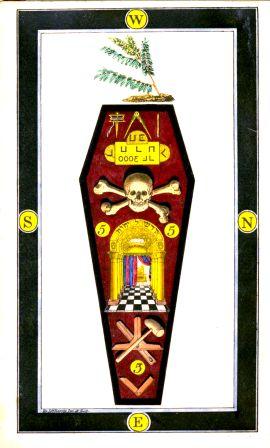
Hiram, Hermes and Herne
I mentioned above that Hiram was a master of something or other. A deeper look at his name reveals what he was master of.
Given that vowels were absent in most ancient writings (such as Egyptian, Hebrew, Greek), the word Hiram can be rendered HRM, which can in turn be re-rendered HERMES.
We see then that Hiram was a Master of Hermes - that is, a Hermetic Master.
Importantly, the name of Hermes harkens back to the Irish Herne. Herne, also known as Cernunnos, Nikor, or the Green Man, was the stag-horned forest god of the ancient Arya. He was seen depicted (like Orpheus and Krishna) sitting tranquilly among the forest animals. Herne was also depicted holding a circlet in one hand and serpent in the other. (As we saw above, the serpent features prominently in the story of Hiram Abiff).
The circlet and serpent motif connotes the number 10, now known as ten.
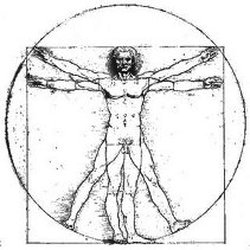
When the Greek letters of the name Hermes are added, we get 343, which equals 10. If the name Hiram connotes the mysteries of the number ten, then Abiff, meaning "Father" or "Elder," simply implies that the number ten was considered the "Father Number." Indeed the ancient architects and geometrists of Egypt, Greece and Ireland held the number in high esteem. Ten was a most sacred number.
Primordial gods (such as Atum Ra) and archetypal figures (such as Adam) were esoterically associated with the number ten. In English numerology, the letters of ATUM (1, 2, 3, 4) add to 10.
This is the same for the letters of the name ADAM (1, 4, 1, 4). The human hands figuratively denote 1414 - that is one thumb and four fingers, on each hand - ergo 1414 (or 10). Ergo, the numerological testament proclaims each and every man to be an "Adam."
In their book entitled The Hiram Key, Masonic authors Christopher Knight and Robert Lomas contend that Hiram Abiff was Pharaoh Seqenenre Tao II, of Egypt's seventeenth dynasty. (Click here for more on this pharaoh).

Jacques de Molay. Grand Master of the French Knights Templar during the fourteenth century. He was allegedly condemned to death as a heretic by King Philip IV. Like most of the Templar nobility, he had visited England and was probably educated by Culdean Monks from Ireland. Masonic lore tells us that he bore the title "Hiram Abiff," which lends credence to my contention that (like David and Solomon, etc) Hiram Abiff was indeed a title and not a personal name. (Here for more on the Templars.)
Additional Symbolic Examples
The god Mercury, who was associated with the language and the arts of communication, wasoriginally the Irish god known as Ogma, \son of the supreme Irish goddess Brigit.
Mercury was the Roman rendition of the Hellenistic Hermes, who was based on Thoth of the Egyptians and Herne of the Irish. Thoth's name can also be rendered as Tut orTaut, a name close to the English word truth.
Words such as tote (to calculate) taught, throat, talk and thought, etc, come from this god's name. Herne (also known as Cernunnos or Nikor) was the forest god of the ancient Druids. Herne is also a prototype of the Hindu Shiva (or Pashupati). Ogma's name is pronounced auma,or as a long-sounding aum. This is close to the Sanskrit sacred phoneme AUM. One of Ogma's titles was "the Honey Mouth." He was also the god of strength. To this day the ancient Irish alphabet is known as the ogham. Versions of the ogham have been found as far off as America and Bosnia, although the evidence has been carefully covered up.
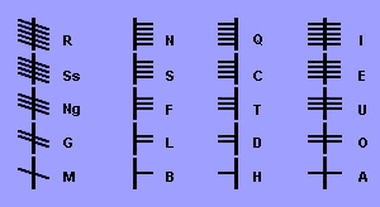
The sacred Ogham alphabet of the Druids. (For more information, see Volume One, Chapter 14, entitled Lost Language of the Ancients.)
They worship chiefly the god Mercury; of him there are many symbols, and they regard him as the inventor of all the arts, as the guide of travelers, and as possessing great influence over bargains and commerce. After him they worship Apollo and Mars, Jupiter and Minerva. About these they hold much the same beliefs as other nations. Apollo heals diseases, Minerva teaches the elements of industry and the arts, Jupiter rules over the heavens, Mars directs war...All the Gauls assert that they are descended from Dispater, their progenitor - Julius Caesar (on the religion of the Irish and Druids, from: de Bell. Gall. vi. 17, 18)
The Kabala
The Kabala of the Jews is but the distorted echo of the Secret Doctrine of the Chaldeans - H. P. Blavatsky
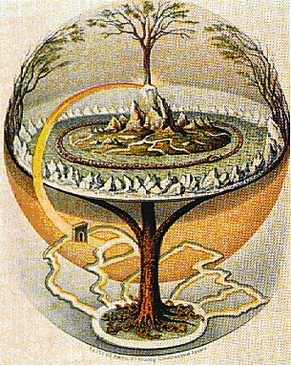
The sacred alphabet, together with the veneration of the sacred tree, reached the Orient and, after adaptation, the alphabet became the foundation of the Phoenician and Hebrew scripts. Hebrew is related to Gaelic, and is the "lost" alphabet of the Egyptians. It possessed 22 letters and 5 vowels. These secrets, concerning the magical operations of these letters, was transmitted in the mystery schools of old. Today, it has been discovered that these 22 letters denote the 22 pathways on the Kabalistic Tree of Life. The Kabala, and its related disciplines, comes not from the Israelites but from the Druids. It was they who would have used this pagan image (of a tree) and who would have likened the journey of mental and spiritual enlightenment to the paths or branches of a tree. This symbolism does not originate with those races taking the credit for it today. Top Jewish rabbis and scholars have deftly concealed their own puzzlement concerning the Kabala and why it is part of their rabbinical canon. They take credit for it and pretend that they understand it, but they do not know its origins or how it really came into their possession. It did so from their association with the Egyptian Solar Cult of Aton.
Like many Egyptian idioms and teachings the Kabala was absorbed by association. It is not acreation of the Old Testament Jews. Researcher Kieran Barry (although he is not concerned with the Irish or the Druids) offers compelling evidence to show that the Kabala was known to the Greeks before it was known to the Jews. What he does not realize is that it came to the Greeks by way of the Hermetic colleges themselves founded upon Druidic mystery traditions.
Of all the modern researchers into this field, it was Robert Graves, Godfrey Higgins, Albert Churchward, and the great Gerald Massey, who understood the truth presented here concerning the Irish origins of the Kabala, the Tree of Life and the sacred alphabets.
The image of the living organic Tree of Life was a pagan symbol that does not derive from the Levitical tradition.
It was a most ancient motif of ancient Caucasian tribes and it appears in the Scandinavian Viking tradition as Yggdrasil, the cosmic tree that has its roots in the underworld and its branches in the heavens, and which is demarked by seven major stages, in a similar way as we find in the chakra system. Around Yggdrasil coils the serpent, another symbol employed largely by the Irish and the Egyptians. (Here for more...)
...we can see that the greater number of the peculiar features of this history existed in Egypt - the tree of life and knowledge, the serpent of Paradise, Eve thinking of appropriating divinity to herself, and in short Adam himself, are all there - M. Lefébure
One is filled with admiration, on penetrating into the Sanctuary of the Kabalah, at seeing a doctrine so logical, so simple, and at the same time so absolute. The necessary union of ideas and signs, the consecration of the most fundamental realities by the primitive characters; the Trinity of Words, Letters, and Numbers; a philosophy simple as the alphabet, profound and infinite as the Word; theorems more complete and luminous than those of Pythagoras; a theology summed up by counting on one's fingers; an Infinite which can be held in the hollow of an infant's hand; ten ciphers and twenty-two letters, a triangle, a square, and a circle - these are all the elements of the Kabalah. These are the elementary principles of the written Word, reflection of that spoken Word that created the world! - Albert Pike (Morals and Dogma)
On the names of the angels and name of Israel, the learned scholar Logan Mitchell wrote:
...learned critics have shown that the Bible names of angels, such as Gabriel, Uriel, Raphael, Michael, Satan, etc., are purely Chaldean or Persian! And this is confirmed by the Talmud of Jerusalem, which says expressly that the Jews borrowed the names of the angels from the Babylonians. Even the name Israel is not a Hebrew but a Chaldee word, as was fully explained by Philo Judaeus, when on his embassy to the Emperor Caligula - (Religion in the Stars, or Mythology Unveiled, 1881)
The Number Three
Among the most amazing and important events of the Ptolemaic period was the establishment of the cult of the Egyptian Osiris trinity as the official religion of a state ruled by Macedonian Greeks with the result that the cult of Isis spread throughout the Mediterranean world becoming the most popular religion of the age. The cult of Isis, Osiris, and Horus was transmitted to Rome where, by the time of Christ, it had become the most popular religious faith of Romans, especially Roman soldiers - R. A. Gabriel (Jesus the Egyptian)
The number three was extremely important in the Shamanic tradition because it represented the harmonious median between conflicting polarities, such as ignorance and knowledge, or folly and wisdom, etc. Three represented the agents of harmony. The Druids understood that nature did not possess such vexatious dichotomies, but that the minds of men most certainly did. Duality was a phenomenon of consciousness, not of nature, even though a fragmented psyche may erroneously project that falsity, and then believe it to be the case.
...like the God of the Jews, of the Chaldees, of the Hindoos, and of the Christians, this Deity of the Druids had three attributes within himself, and each attribute was a god - W. Winwood Reade
In Welsh the word for three is tri, and that is the same in Sanskrit. The Irish Gaelic word for Trinity is Triquetra, which is similar to the Sanskrit word Trikuta, which means "Three Peaks." In Egypt, the hieroglyphic depicting three peaks or hills signified "foreigners," or travelers from distant lands.
Druidic Ireland was divided according to the hemispheres of consciousness. There were four main counties, with one administrative center making the fifth sacred province. This province was called Mide, (or Meath) which meant the middle place. The capital city Tara was situated there, as well as the great astronomical megaliths (Newgrange, Knowth, Dowth and other impressive geomantic sites). The Egyptian supreme goddess of balance and harmony was called Ma'at, and this word is of Gaelic origin. Ma'at is the great mother, the same type as Danu or Brigit. Her name meant "straight," "true," or "just." The hieroglyph denoting Ma'at also signified the mathematical formula one half (1 divided by 2).
The power of the Magi lay in their understanding and application of the properties of theThird Principle. Iesa, the third aspect of the Druidic Trinity, was their most venerated god. Iesa was the prototype of Jesus and he can also be linked to the Hindu god Shiva, the lord of deconstruction and renewal. This Third Principle turns up in the Christian canon as the Holy Spirit, the symbol of which is the dove.
...among the whole of them three classes more especially are held in distinguished veneration, the Bards, the Ovates, and the Druids. The Bards are chanters and poets. The Ovates are…physiologists. The Druids, in addition to physiology, practice ethic philosophy. They are deemed to be most upright, and, in consequence, to them are committed both public and private controversies, in as much that on some occasions they decide on battles and stop the combatants on the eve of engaging. These and others say that souls are immortal, and that the world is so too; yet that ultimately fire and water will prevail - Strabo (First Century Greek historian and geographer)
We find the archetype of threeness expressed throughout the esoteric Kabalistic doctrine, that was originally based on the teachings of the Druids. Druidic colleges employed tripartite divisions. The very Druidic Order was subdivided into three parts. And the Druidic Trinity (Bel, Taranis, Esus) was surely the archetype upon which all others were based.
Ancient Egyptian religion had from the earliest times displayed a natural inclination to the arrangement of its gods in groupings of threes, or "triads." Following the model of Osiris - Isis - Horus, the triad later took on a "familial" pattern of father-mother-child, and several cities worshiped their own particular variations on theme - Nicholas Reeves
Hebrew theology was divided into three distinct parts. The first was the law, the second was the soul of the law, and the third was the soul of the soul of the law. The law was taught to all the children of Israel; the Mishna, or the soul of the law, was revealed to the Rabbis and teachers; but the Qabalah, the soul of the soul of the law, was cunningly concealed, and only the highest initiates among the Jews were instructed in its secret principles - Manly Palmer Hall (The Secret Teachings of All Ages)
The Druids based their trinity on their observations and veneration of the heavens. Their three gods were personifications of the three stars of Orion's belt. The constellation of Orion has been revered throughout the ages from the earliest times.
CONTINUE TO PAGE III...
![]()
![]()
![]()
![]()
Disclaimer:
Some material presented will contain links, quotes, ideologies, etc., the contents of which should be understood to first, in their whole, reflect the views or opinions of their editors, and second, are used in my personal research as "fair use" sources only, and not espousement one way or the other. Researching for 'truth' leads one all over the place...a piece here, a piece there. As a researcher, I hunt, gather and disassemble resources, trying to put all the pieces into a coherent and logical whole. I encourage you to do the same. And please remember, these pages are only my effort to collect all the pieces I can find and see if they properly fit into the 'reality aggregate'.
Personal Position:
I've come to realize that 'truth' boils down to what we 'believe' the facts we've gathered point to. We only 'know' what we've 'experienced' firsthand. Everything else - what we read, what we watch, what we hear - is what someone else's gathered facts point to and 'they' 'believe' is 'truth', so that 'truth' seems to change in direct proportion to newly gathered facts divided by applied plausibility. Though I believe there is 'truth', until someone representing the celestial realm visibly appears and presents the heavenly records of Facts And Lies In The Order They Happened, I can't know for sure exactly what "the whole truth' on any given subject is, and what applies to me applies to everyone. Until then I'll continue to ask, "what does The Urantia Book say on the subject?"
~Gail Bird Allen
![]()
![]()








-
Urantia Book, 44:0.11 - The Celestial Artisans
Never in your long ascendancy will you lose the power to recognize your associates of former existences. Always, as you ascend inward in the scale of life, will you retain the ability to recognize and fraternize with the fellow beings of your previous and lower levels of experience. Each new translation or resurrection will add one more group of spirit beings to your vision range without in the least depriving you of the ability to recognize your friends and fellows of former estates.
-
Princess Bride 1987 Wallace Shawn (Vizzini) and Mandy Patinkin (Inigo Montoya)
Vizzini: HE DIDN'T FALL? INCONCEIVABLE.
Inigo Montoya: You keep using that word. I do not think it means what you think it means. -
Urantia Book, 117:4.14 - The Finite God
And here is mystery: The more closely man approaches God through love, the greater the reality -- actuality -- of that man. The more man withdraws from God, the more nearly he approaches nonreality -- cessation of existence. When man consecrates his will to the doing of the Father's will, when man gives God all that he has, then does God make that man more than he is.
-
Urantia Book, 167:7.4 - The Talk About Angels
"And do you not remember that I said to you once before that, if you had your spiritual eyes anointed, you would then see the heavens opened and behold the angels of God ascending and descending? It is by the ministry of the angels that one world may be kept in touch with other worlds, for have I not repeatedly told you that I have other sheep not of this fold?"
-
Urantia Book, Foreword - 0:12.12 - The Trinities
But we know that there dwells within the human mind a fragment of God, and that there sojourns with the human soul the Spirit of Truth; and we further know that these spirit forces conspire to enable material man to grasp the reality of spiritual values and to comprehend the philosophy of universe meanings. But even more certainly we know that these spirits of the Divine Presence are able to assist man in the spiritual appropriation of all truth contributory to the enhancement of the ever-progressing reality of personal religious experience—God-consciousness.
-
Urantia Book, 1:4.3 - The Mystery Of God
When you are through down here, when your course has been run in temporary form on earth, when your trial trip in the flesh is finished, when the dust that composes the mortal tabernacle "returns to the earth whence it came"; then, it is revealed, the indwelling "Spirit shall return to God who gave it." There sojourns within each moral being of this planet a fragment of God, a part and parcel of divinity. It is not yet yours by right of possession, but it is designedly intended to be one with you if you survive the mortal existence.
-
Urantia Book, 1:4.1 - The Mystery Of God
And the greatest of all the unfathomable mysteries of God is the phenomenon of the divine indwelling of mortal minds. The manner in which the Universal Father sojourns with the creatures of time is the most profound of all universe mysteries; the divine presence in the mind of man is the mystery of mysteries.
-
Urantia Book, 1:4.6 - The Mystery Of God
To every spirit being and to every mortal creature in every sphere and on every world of the universe of universes, the Universal Father reveals all of his gracious and divine self that can be discerned or comprehended by such spirit beings and by such mortal creatures. God is no respecter of persons, either spiritual or material. The divine presence which any child of the universe enjoys at any given moment is limited only by the capacity of such a creature to receive and to discern the spirit actualities of the supermaterial world.
-
Urantia Book, 11:0.1 - The Eternal Isle Of Paradise
Paradise is the eternal center of the universe of universes and the abiding place of the Universal Father, the Eternal Son, the Infinite Spirit, and their divine co-ordinates and associates. This central Isle is the most gigantic organized body of cosmic reality in all the master universe. Paradise is a material sphere as well as a spiritual abode. All of the intelligent creation of the Universal Father is domiciled on material abodes; hence must the absolute controlling center also be material, literal. And again it should be reiterated that spirit things and spiritual beings are real.
-
Urantia Book, 50:6.4 - Planetary Culture
Culture presupposes quality of mind; culture cannot be enhanced unless mind is elevated. Superior intellect will seek a noble culture and find some way to attain such a goal. Inferior minds will spurn the highest culture even when presented to them ready-made.
-
Urantia Book, 54:1.6 - True And False Liberty
True liberty is the associate of genuine self-respect; false liberty is the consort of self-admiration. True liberty is the fruit of self-control; false liberty, the assumption of self-assertion. Self-control leads to altruistic service; self-admiration tends towards the exploitation of others for the selfish aggrandizement of such a mistaken individual as is willing to sacrifice righteous attainment for the sake of possessing unjust power over his fellow beings.
-
Urantia Book, 54:1.9 - True And False Liberty
How dare the self-willed creature encroach upon the rights of his fellows in the name of personal liberty when the Supreme Rulers of the universe stand back in merciful respect for these prerogatives of will and potentials of personality! No being, in the exercise of his supposed personal liberty, has a right to deprive any other being of those privileges of existence conferred by the Creators and duly respected by all their loyal associates, subordinates, and subjects.
-
Urantia Book, 54:1.8 - True And False Liberty
There is no error greater than that species of self-deception which leads intelligent beings to crave the exercise of power over other beings for the purpose of depriving these persons of their natural liberties. The golden rule of human fairness cries out against all such fraud, unfairness, selfishness, and unrighteousness.

